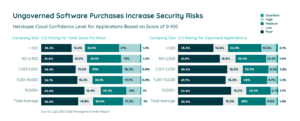
Zylo Wrapped 2025: SaaS Spend, AI Impact, and What’s Next
Table of Contents ToggleKey Themes That Shaped SaaS Management in 20251....
Back
Back
Search for Keywords...
Blog

10/30/2025
Table of Contents
IT spend optimization has become a top priority as technology budgets expand and decentralize. In fact, Zylo customers rank reduced software costs as the number one outcome of their SaaS Management program.
Value can quickly erode, however, as license waste, shadow IT, and overlapping tools proliferate software portfolios. You can’t afford to cut discriminately, as your business depends on the right investments to keep innovating. Then what’s the best approach to optimizing IT spend?
In this article, explore the frameworks, tools, and best practices you can use to maximize the value of your IT budget. From understanding fixed and variable costs to adopting cloud efficiency strategies and vendor management tactics, learn how to cut waste while keeping technology aligned with your business goals.
Today, the average organization spends $49M on SaaS annually—according to the 2025 SaaS Management Index. As a result, IT spend optimization becomes critical to reducing costs. IT spend optimization is the practice of managing your technology investments to deliver maximum value while minimizing waste. It:

Unlike short-term cost-cutting, optimization takes a strategic view. It examines your entire technology portfolio to ensure every dollar supports your business goals. As your SaaS and cloud usage grows, so do the risks of ballooning costs from duplicate licenses, unused seats, or overlapping tools. By focusing on visibility, ongoing monitoring, and clear purchasing policies, you can ensure that your investments reduce inefficiency without hindering innovation.
To optimize your technology spend, you need to understand how your IT costs are structured. Start by understanding:
Breaking costs into categories:
A clear framework often distinguishes between fixed and variable costs, as well as direct and indirect costs. By understanding these distinctions, you’ll know which costs can be adjusted quickly and which require longer-term planning.
It’s easy to confuse IT spend optimization with cost reduction, but they aren’t the same. The key differences include:
While both cost reduction and spend optimization aim to control expenses, these approaches take different paths and yield different outcomes. Understanding the distinction helps IT leaders make decisions that save money without undermining long-term goals.
Focusing only on cost-cutting can deliver quick wins but leaves the organization vulnerable to disruption. Optimization, on the other hand, ensures that every dollar supports business priorities, providing both savings and the ability to innovate.
Guide to Managing SaaS Costs
Learn MoreOptimizing your IT spend is crucial because it:
For 2025, IT leaders rank improving employee productivity, reducing security risks, and cutting operational expenses as their top priorities—all goals directly supported by effective spend optimization.
As your SaaS and cloud portfolios grow, so do the risks of overspending, duplication, and compliance gaps. Without a clear optimization strategy, you may find your budget consumed by low-value or redundant tools.
In addition, focusing on optimization also makes you more agile. By monitoring usage, reallocating resources, and establishing policies, you can respond more effectively to shifting business priorities. This ensures your IT budget supports both financial discipline and innovation, giving you the flexibility to grow without wasting money.
You have more control over IT costs than you might think. These 17 techniques can help your organization cut waste, make smarter investments, and ensure every dollar supports your business goals.
Start by auditing your entire IT environment. Catalog every application, service, and infrastructure component to uncover duplicate tools, unused licenses, and underutilized resources. When you know exactly what you’re paying for and who’s using it, you’ll have the foundation for better decisions.
Look at whether your current tools truly deliver value. You may find opportunities to consolidate overlapping apps or move to platforms with broader functionality. Choosing cost-effective solutions results in right-sizing your tools so you only pay for what you use.
Cloud services can be a cost advantage, but only if you manage them carefully. Rightsize workloads, schedule idle resources to shut down, and take advantage of reserved or spot instances. When you treat the cloud like a utility, you can pay only for what you need.
Automate repetitive tasks like provisioning, license reclamation, and spend reporting to save time and reduce errors. By eliminating manual work, you not only cut costs but also free up your team to focus on higher-value projects.
Centralizing vendor management gives you more leverage. You can negotiate better pricing, align renewal cycles, and eliminate redundant contracts. When you regularly review your vendors, you’re more likely to secure favorable terms and reduce long-term spend.
Don’t let contract fine print catch you off guard. Auto-renewals, rigid seat counts, or minimum spend clauses can lock you into paying for more than you need. Review agreements closely, renegotiate when possible, and opt for flexible contracts that allow you to scale up or down as needed.
Not every project deserves equal funding. Focus your budget on initiatives tied to revenue, compliance, or customer outcomes while putting lower-priority projects on hold. This way, you make sure your resources always drive the greatest impact.
Watch this short video for more on prioritizing apps and finding those with the best spend optimization opportunity.
Every IT investment should tie directly to your company’s strategy. When you map spend to outcomes like growth, compliance, or customer satisfaction, you can justify your budget and show leadership the value IT delivers.
Consider places where open-source or free tools could replace expensive licenses. With the right planning for support and updates, you can use these options to significantly reduce costs while still meeting your needs. Carefully evaluate the total cost of ownership before making the switch.
Create clear policies for procurement, renewals, and tool adoption. By setting guardrails, you’ll reduce fragmented purchases and shadow IT. Clear policies give your team structure while still leaving room for flexibility where needed.
Optimization is an ongoing process. By monitoring usage patterns and spend trends, you can catch waste early. Reporting through dashboards or scheduled updates helps you adjust quickly before small issues become costly problems.
A tool is only valuable if people know how to use it. Training boosts adoption, reduces wasted licenses, and helps your employees make smarter choices. The more confident your team is with your tech, the higher the return on your investment.
Showback and chargeback models make costs visible across departments. When your business units see exactly how their usage translates into spend, they become more mindful of how they consume resources. Transparency leads to accountability.
Create a standardized procurement process to prevent duplication and waste. When you create clear steps for evaluating and approving tools, you make it easier for your teams to get what they need while keeping spend under control.
Reclaiming inactive licenses is one of the quickest ways to gain a win in IT optimization. Automating reclamation ensures unused seats are reassigned rather than wasted. This way, you get the most from the licenses you already pay for.
Watch this short video for best practices for license reclamations.
Benchmarking helps you see how your spend compares to peers. If you’re overspending in certain areas, benchmark to highlight where to adjust. Using industry data also strengthens your case when you need to make changes or renegotiate contracts.
Bring IT and Finance closer together to connect usage insights with budgeting expertise. By working together as partners, you can identify inefficiencies more quickly and align spending with business priorities. Collaboration ensures your optimization strategies stick.
As CIO, you’re being asked to do more with less while keeping the business secure and productive. Balancing innovation with cost control is no small task, and the pressures are only growing.
Common challenges for CIOs include:
On top of that, you’re expected to deliver measurable value from every dollar spent. Business leaders want proof that IT investments translate into productivity, cost savings, or new revenue opportunities. Without visibility, that’s hard to achieve. The reality is that CIOs need new ways to track usage, enforce policies, and ensure spend is aligned with strategy—otherwise, costs continue to climb unchecked.
Technology trends are reshaping how you think about IT budgets. Some create new opportunities, while others add cost and risk that you have to manage.
These trends stand out:
Together, they explain why IT spend is rising so quickly and why optimization has never been more important.
AI has moved from experiment to essential line item in your IT budget. Over the past year, the SaaS Management Index survey found that 77.6% of IT leaders reported upgrading or investing more in SaaS apps for their AI capabilities. That surge shows just how fast AI is being embedded into the everyday tools your employees use.
The challenge is making sure those investments deliver real outcomes. Without oversight, you could end up paying for AI features in multiple tools, many of which overlap. By tracking adoption and measuring ROI, you’ll ensure AI spend drives productivity instead of waste.
Cybersecurity is one of the costliest areas of IT spend—and for good reason. In the average SaaS portfolio, 60.8% of expensed software has a “Poor” or “Low” risk score, exposing organizations to major security and compliance gaps. Those risks are expensive: the global average cost of a data breach now sits at $4.4M—per IBM’s 2025 Cost of a Data Breach Report.

If you don’t monitor risk across your SaaS portfolio, you may spend more fixing breaches than you save through optimization. Strong governance, risk assessments, and vendor evaluations help you protect both your budget and your reputation.
Purchasing power continues to shift outside of IT. Today, IT is responsible for just 26% of SaaS spending, leaving the majority of purchases in the hands of business units. Combine that with the fact that the average SaaS portfolio is growing 33.2% annually, and you have a recipe for sprawl.

For you, this trend means spending is harder to track and control. Without centralized visibility, redundant apps multiply, contracts overlap, and budgets get stretched thin. Optimization requires reining in decentralized spend with better inventory management, cost allocation, and governance.
Another trend shaping IT budgets is the focus on sustainability. More organizations are evaluating the carbon impact of their tech stacks, from data centers to SaaS hosting. While green IT can sometimes carry upfront costs, efficiency measures like consolidating infrastructure or choosing vendors with renewable energy commitments often reduce spending in the long run.
By prioritizing sustainable practices, you can achieve two key objectives simultaneously: reducing costs and aligning with the growing expectations of ESG stakeholders.
The best way to understand the impact of IT spend optimization is to see how other organizations have applied it. The examples below illustrate the business impact of SaaS Management and Optimization.
IT spend optimization isn’t limited by company size or industry. The principles are the same: gain visibility, implement SaaS operations, and reduce waste. With the right strategy, you can reduce costs, strengthen governance, and create lasting value for your business.
Modernizing Medicine faced managing hundreds of SaaS applications without full visibility into costs, usage, or risk. By implementing Zylo, the company gained a clear picture of its SaaS environment and took control of spending decisions.
Key results included:
For CIOs and IT leaders, the takeaway is clear: visibility and automation create measurable financial impact while strengthening governance. Read the whole story for more details.
ModMed Drives Operational Excellence & Million-Dollar Savings with Zylo SaaS License Management
Discover how ModMed used Zylo’s powerful license tracking and optimization to save millions of dollars, drive operational excellence, and improve the employee experience.
As a growing company, Adobe needed to understand the full scope of its SaaS environment, eliminate redundant applications, and reclaim wasted licenses. With Zylo, Adobe created a scalable program that reduced costs, streamlined its portfolio, and improved employee experience.
Key results included:
Adobe’s results highlight how spend optimization can scale across even the largest enterprises, driving both financial savings and operational efficiency. Explore the full case study for more about their substantial outcomes.
Adobe Drives Innovation and Massive Savings with Zylo
In the past 4 years, Adobe has rapidly scaled from $9B to $18B. This growth has made an already complex environment even more complex. Learn how they leveraged Zylo to get complete visibility into their SaaS portfolio, unlock millions in cost savings and avoidance and improve the employee experience.
Optimizing IT spend means making smarter decisions that support your business goals. From understanding the true structure of your IT costs to reclaiming unused licenses and strengthening vendor management, the steps outlined here give you a framework for lasting impact. The case studies from Modernizing Medicine and Adobe show what’s possible when you have full visibility and the right tools in place.
If you’re ready to see the same kind of results in your organization, explore Zylo’s solutions to start building a more efficient, accountable, and innovative approach to IT spend optimization. Request a demo to see Zylo’s spend optimization in action.

Table of Contents ToggleKey Themes That Shaped SaaS Management in 20251....

Table of Contents ToggleWhat Is IT Spend Optimization?Understanding IT CostsFixed and...

Table of Contents ToggleWhat Is IT Spend Optimization?Understanding IT CostsFixed and...

Table of Contents ToggleWhat Is IT Spend Optimization?Understanding IT CostsFixed and...
| Cookie | Duration | Description |
|---|---|---|
| cookielawinfo-checkbox-analytics | 11 months | This cookie is set by GDPR Cookie Consent plugin. The cookie is used to store the user consent for the cookies in the category "Analytics". |
| cookielawinfo-checkbox-functional | 11 months | The cookie is set by GDPR cookie consent to record the user consent for the cookies in the category "Functional". |
| cookielawinfo-checkbox-necessary | 11 months | This cookie is set by GDPR Cookie Consent plugin. The cookies is used to store the user consent for the cookies in the category "Necessary". |
| cookielawinfo-checkbox-others | 11 months | This cookie is set by GDPR Cookie Consent plugin. The cookie is used to store the user consent for the cookies in the category "Other. |
| cookielawinfo-checkbox-performance | 11 months | This cookie is set by GDPR Cookie Consent plugin. The cookie is used to store the user consent for the cookies in the category "Performance". |
| viewed_cookie_policy | 11 months | The cookie is set by the GDPR Cookie Consent plugin and is used to store whether or not user has consented to the use of cookies. It does not store any personal data. |
